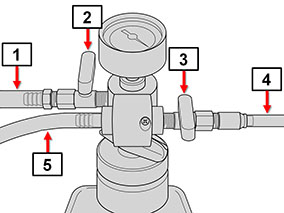Tesla Model S: Cooling System - Vacuum Refill
Tesla Model S (2012-2025) Service Manual / Thermal Management / Cooling System - Vacuum Refill
Note: Make sure at least 14 L of the specified coolant is available before beginning this procedure.
Caution: Use the specified coolant only. In this manual, refer to General Information > Capacities, Fluids, and Lubricants > Fluids. Refill
- Use Toolbox to prepare the vehicle for draining and refilling
coolant:
- Connect a laptop with Toolbox 2.0 or higher to the vehicle.
- Oen the "Fluid Drain and Fill" panel.
- Check the "Coolant Panel" check box.
- In the "Routine" dropdown menu, select Fluid Drain/Fill.
- Press the Start/Play button.
Before continuing this procedure, inspect the "Thermal" mode readout on the touchscreen and ensure that the powertrain and battery systems are in "series" mode".
- Use the Thermal System Signals panel to verify that the system is in series mode and the coolant valves are set to 50%.
- Attach the reservoir adapter to the vacuum refill tool.
- Ensure that the coolant refill valve and the air inlet valve are
closed.

1 Coolant refill hose 2 Coolant refill valve 3 Air inlet valve 4 Shop air supply 5 Overflow hose - Connect shop air supply with a minimum pressure of 5.5 bar (80 PSI) to the vacuum refill tool.
- Place the end of the overflow hose in a suitable container to collect any coolant that is drawn out of the system when the vacuum is applied.
- Open the air inlet valve. Note: A hissing noise is normal.
- Allow the tool to evacuate the system until the needle on the vacuum gauge reaches the green range or the needle stops moving. Note: It is normal for some cooling hoses to collapse due to the vacuum in the system.
- Close the air inlet valve and monitor the gauge for approximately 30 seconds to verify that a vacuum is maintained in the cooling system. Note: If the gauge reading drops, there is a leak in the system that must be fixed before refilling with coolant.
- Position a container of coolant at, or as close as possible to, the height of the coolant reservoir. Note: The container should be filled with at least 14 L of the specified coolant. Caution: Use the specified coolant only. In this manual, refer to General Information > Capacities, Fluids, and Lubricants > Fluids.
- Place the end of the coolant refill hose into the coolant container. Ensure that the end is fully submerged. Tip: If the container is especially deep, the end of the hose might float in the coolant. Use a weight, hanger, or other tool to keep the end of the hose submerged in the coolant.
- Very slowly open the coolant refill valve to allow coolant to be drawn into the coolant refill hose. Close the valve when the hose is full of coolant. This purges trapped air from the hose.
- Reopen the air inlet valve. Close the valve when the vacuum gauge needle stops rising.
- Slowly open the coolant refill valve to allow coolant to be drawn into the system. Caution: Ensure that the end of the coolant refill hose remains submerged to prevent air from being drawn into the system. Immediately close the coolant refill valve if air enters the coolant refill hose.
- Once the gauge stops moving, close the coolant refill valve.
- Remove the vacuum refill tool:
- Leave the coolant refill hose in the container.
- Lift the tool from the reservoir.
- Holding the tool above the container, open the coolant refill valve to drain the coolant from the refill hose into the container.
- Start the cooling system bleed procedure (refer to procedure).
Tip: It is not necessary to run the complete (15 minute) bleed routine. The bleed routine can be stopped once the coolant level has stabilized.
READ NEXT:
 Radiator (Remove and Replace)
Radiator (Remove and Replace)
Removal
Drain the cooling system (refer to procedure).
Remove the front fascia assembly for access (refer to
procedure).
Release the clamps (x2) that secure the feed and return ho
 Reservoir Assembly - Coolant (Remove and Replace)
Reservoir Assembly - Coolant (Remove and Replace)
Warning: If the 12V power supply is disconnected, do
not attempt to open any doors with door glass in closed position.
Failure to follow this instruction could result in door glass
shat
 Reservoir Assembly - Coolant (Dual Motor) (Remove and Replace)
Reservoir Assembly - Coolant (Dual Motor) (Remove and Replace)
Warning: If the 12V power supply is disconnected, do
not attempt to open any doors with door glass in closed position.
Failure to follow this instruction could result in door glass
shat
SEE MORE:
 12V Battery Bracket Beam (Remove and Replace)
12V Battery Bracket Beam (Remove and Replace)
Removal
Remove the 12V battery (refer to procedure).
Release the 2 bolts that secure the 12V battery bracket to the
front crossmember (torque 15 Nm).
Remove the 12V battery tray.
 Carpet - Interior Complete (Remove and Replace)
Carpet - Interior Complete (Remove and Replace)
Removal
Remove driver seat (refer to procedure)
Remove passenger seat.
Remove driver footrest (refer to procedure)
Remove LH sill panel trim (refer to procedure)
Remove RH sill panel trim.
Remove rear seat cushion (refer to procedure)
Loosen bolts (x2) securing front
© 2019-2025 Copyright www.tesms.org

